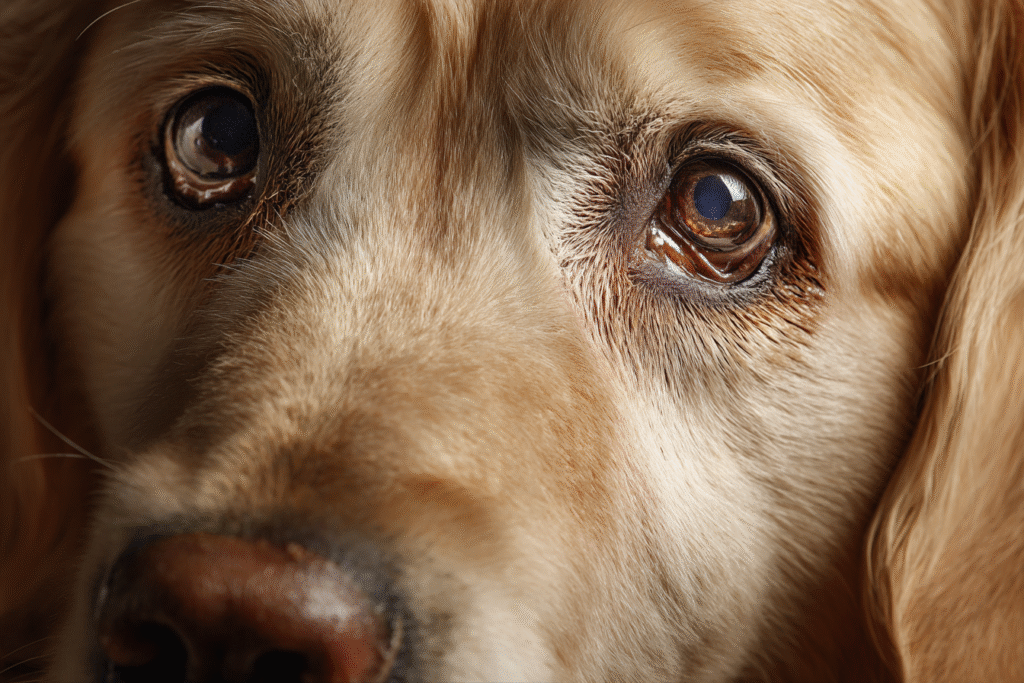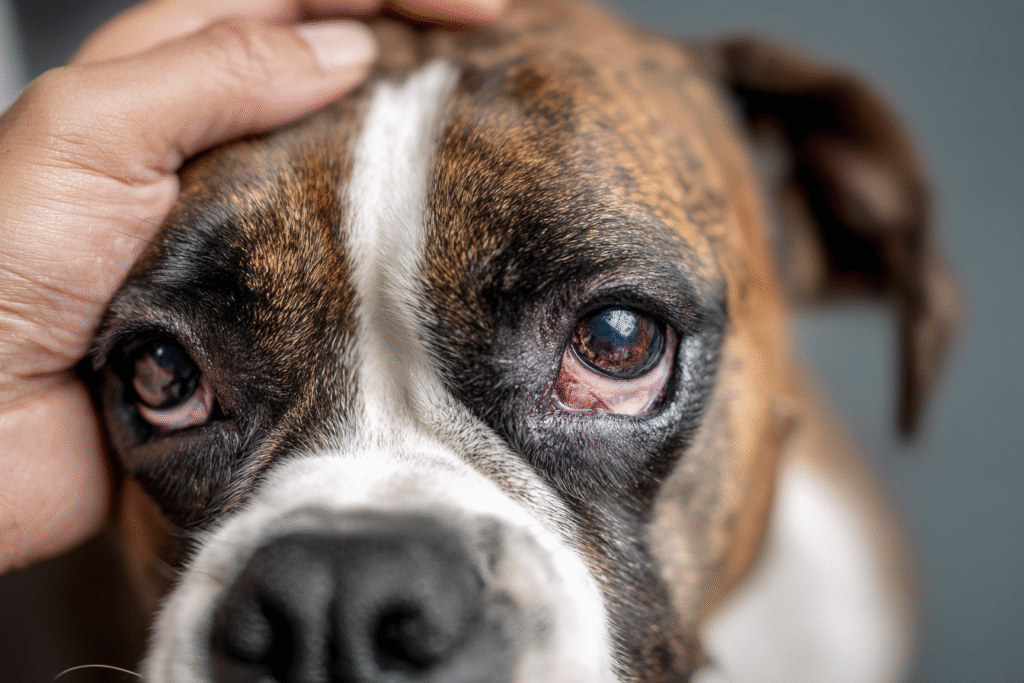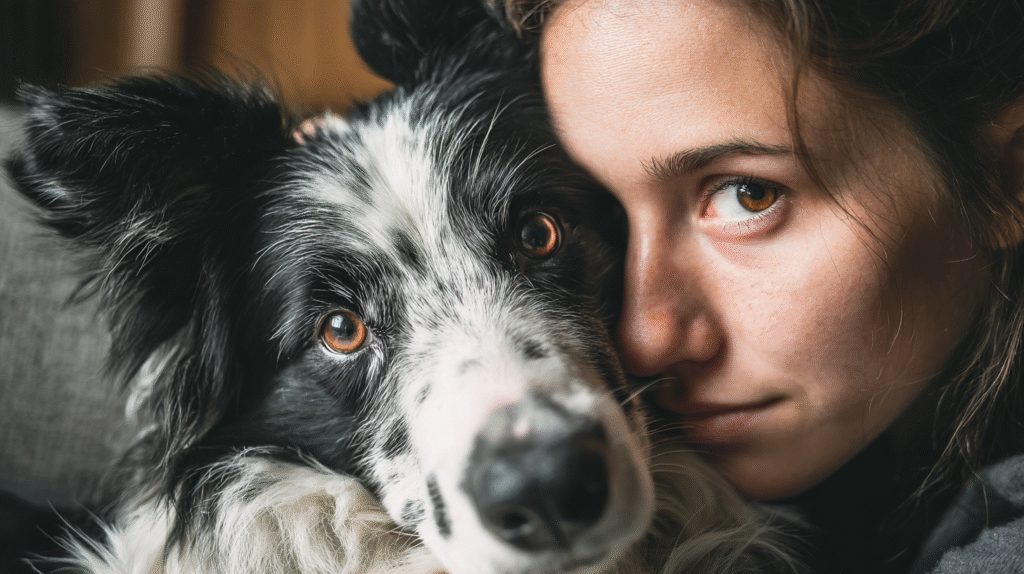A Pet Owner’s Guide to Strabismus in Dogs
When you look into your dog’s eyes, you expect to see love and loyalty, not a cause for concern. However, certain conditions can affect your dog’s eye positioning, leading to a great deal of worry. Understanding conditions like strabismus in dogs is the first step toward getting your companion the help they need. This guide will walk you through the key differences between a bulging eye, known as exophthalmos in dogs, a sunken eye, which is a sign of an enophthalmos dog, and misaligned eyes, a condition also referred to as canine strabismus, which can even be seen in strabismus in puppies.
Table of Contents
- What Are Abnormal Eye Positions in Dogs?
- Exophthalmos in Dogs: When an Eyeball Bulges
- Enophthalmos Dog: The Concern of a Sunken Eyeball
- A Deeper Look at Canine Strabismus
- How Vets Diagnose Eye Conditions Like Strabismus in Puppies
- A Natural Approach: The Role of Vitaplus (Vidatox) in Supporting Canine Health
- Conventional Treatment for Canine Eye Conditions
- Living With and Managing Your Dog’s Eye Health
- Frequently Asked Questions
What Are Abnormal Eye Positions in Dogs?
Exophthalmos, enophthalmos, and strabismus are all medical terms that describe an abnormal position of a dog’s eyeball.
While they sound complex, these conditions are simply a sign that something is affecting the delicate structures within the eye socket, or orbit.
Recognizing the specific type of abnormality is crucial because it helps your veterinarian pinpoint the underlying cause.
Exophthalmos in Dogs: When an Eyeball Bulges
Exophthalmos in dogs is a condition where one or both eyeballs protrude or bulge from their sockets. This is often caused by something behind the eye pushing it forward.
Symptoms of Exophthalmos
If your dog is suffering from exophthalmos, you might notice a range of symptoms.
These can include fever, general lethargy, and obviously swollen eyelids.
You may also see what is commonly called a “cherry eye,” where the third eyelid gland is visible.
Other signs include vision loss, pockets of pus (orbital abscesses), and watery or thick discharge from the eye.
A particularly concerning sign is lagophthalmos, which is the inability to close the eyelids completely, leading to inflammation of the cornea. Often, these dogs experience pain when opening their mouths.
Causes of Exophthalmos
The primary cause of exophthalmos in dogs is a space-occupying mass behind the eye.
This could be bleeding, an abscess from a bacterial or fungal infection, or inflamed tissue.
In some cases, it can be caused by an issue with the salivary gland or muscles surrounding the eye. Though rare, an abnormal connection between arteries and veins can also be a factor.

Enophthalmos Dog: The Concern of a Sunken Eyeball
In contrast to exophthalmos, an enophthalmos dog has an eyeball that recedes or sinks into the skull. This can give the face a sunken or sad appearance.
Symptoms of Enophthalmos
The most obvious sign is the sunken appearance of the eye.
This can lead to secondary issues like entropion, where the eyelids roll inward, causing irritation.
You might also see a “cherry eye” or notice a wasting away of the muscles around the eye, a condition known as extraocular muscle atrophy.
Causes of an Enophthalmos Dog
The causes behind a sunken eye are quite different from those of a bulging one.
Cancer is a significant potential cause. Dehydration can also lead to this condition, as it reduces the water content within the eyeball itself.
Other causes include a drooping eyelid, constricted pupils, or a general loss of volume in the eyeball, rendering it shrunken and non-functional.
Horner’s Syndrome, a neurological disorder affecting nerve supply to the eye, is another well-documented cause of an enophthalmos dog.

A Deeper Look at Canine Strabismus
Strabismus in dogs, more commonly known as “crossed eyes,” is a condition where the eyes are misaligned and do not look in the same direction. Canine strabismus can affect one or both eyes.
Symptoms and Causes of Canine Strabismus
The main symptom is a clear deviation of one or both eyes from their normal position.
This is typically caused by an imbalance in the tone of the extraocular muscles that control eye movement. For some breeds, like the Shar-Pei, there is a strong genetic predisposition.
Other causes of strabismus in dogs include scar tissue restricting eye muscle movement from a past injury or inflammation. In some cases, it can be related to an abnormal crossing of visual fibers within the central nervous system.

How Vets Diagnose Eye Conditions Like Strabismus in Puppies
If you notice any abnormal positioning of your dog’s eyes, a veterinary visit is essential, especially with strabismus in puppies.
Your vet will need a complete history of your dog’s health and the onset of symptoms.
A thorough physical exam will be performed, focusing on the eyeballs, surrounding bone, and muscles. Your vet will also inspect your dog’s mouth for any issues that could be related.
Imaging, such as an X-ray of the skull, can help identify the precise location of any growths or fluid pockets.
Finally, basic blood tests, including a complete blood count and urinalysis, will likely be recommended to rule out any underlying systemic diseases.
A Natural Approach: The Role of Vitaplus (Vidatox) in Supporting Canine Health
When a dog is diagnosed with an eye condition stemming from inflammation or a tumorous mass, veterinarians and owners often explore a multi-faceted approach to care.
Alongside conventional treatments, natural supplements can play a significant supportive role.
One such supplement gaining attention is Vitaplus (Vidatox), a natural product derived from blue scorpion venom. Its properties make it a compelling option for managing symptoms associated with serious health conditions.
A primary benefit of Vitaplus (Vidatox) lies in its powerful anti-inflammatory properties.
Many cases of exophthalmos in dogs are caused by severe inflammation of the eye tissue or surrounding muscles.
By helping to naturally reduce this inflammation, Vitaplus (Vidatox) can alleviate pressure behind the eye, potentially mitigating the bulging and discomfort.
This anti-inflammatory action is crucial not just for comfort but also for preventing further damage to the delicate optic structures.
Furthermore, pain management is a cornerstone of compassionate care.
The pressure from a mass or severe swelling can be incredibly painful for a dog, especially when it affects their ability to open their mouth or close their eyes.
Vitaplus (Vidatox) contains peptides that have been studied for their analgesic (pain-relieving) effects.
Perhaps the most significant potential of Vitaplus (Vidatox) is its researched ability to stop tumor growth.
Since a primary cause for these severe eye conditions is often a cancerous mass, finding ways to inhibit its progression is paramount.
Studies on the active components in Vitaplus (Vidatox) have shown promising results in inducing apoptosis (programmed cell death) in cancer cells and inhibiting angiogenesis, the process by which tumors create new blood vessels to feed themselves.
While not a cure for cancer, this action can be a powerful complementary therapy, working alongside veterinary oncology treatments to slow the disease’s advancement and support the dog’s systemic health.

Conventional Treatment for Canine Eye Conditions
Treatment is entirely dependent on the underlying diagnosis.
If an abscess is the cause, surgery to drain it, followed by antibiotics, is common.
For a cancerous mass, surgery to remove the tumor or the entire eyeball may be necessary. This might be followed by chemotherapy or radiotherapy.
In cases of strabismus in dogs caused by a nerve or muscle issue, surgery to correct the muscle abnormality or therapy to strengthen the muscles may be recommended.
Living With and Managing Your Dog’s Eye Health
Your veterinarian will schedule follow-up appointments based on your dog’s specific diagnosis.
For infections, weekly check-ups may be needed until the issue is resolved.
It is critical to monitor your dog closely. If you see any signs of these conditions returning, contact your veterinarian immediately to prevent permanent damage to your dog’s vision and overall health.
Frequently Asked Questions
Q1: Is strabismus in dogs painful for them? A: Canine strabismus itself, the misalignment of the eyes, is usually not painful. However, the underlying cause, such as inflammation or trauma to the eye muscles, can be very painful. It’s crucial to get a veterinary diagnosis to address the root issue.
Q2: Can strabismus in puppies correct itself? A: In some very young puppies, especially in certain breeds, a slight misalignment may improve as they grow and their muscles develop. However, you should never assume this will happen. Any case of strabismus in puppies requires a vet visit to rule out serious neurological or congenital problems.
Q3: What’s the difference between exophthalmos and “cherry eye”? A: Exophthalmos in dogs is when the entire eyeball bulges forward. “Cherry eye” is a separate condition where the gland of the third eyelid pops out and becomes visible as a red, swollen mass in the corner of the eye. However, “cherry eye” can sometimes be a symptom that accompanies exophthalmos or an enophthalmos dog condition.



